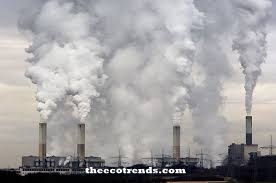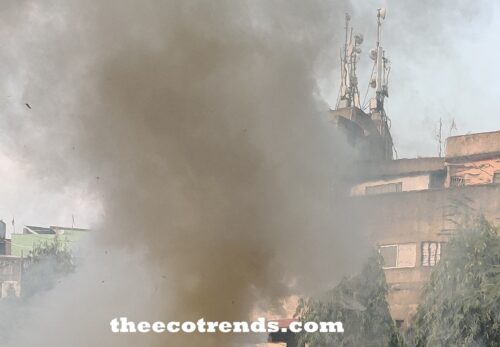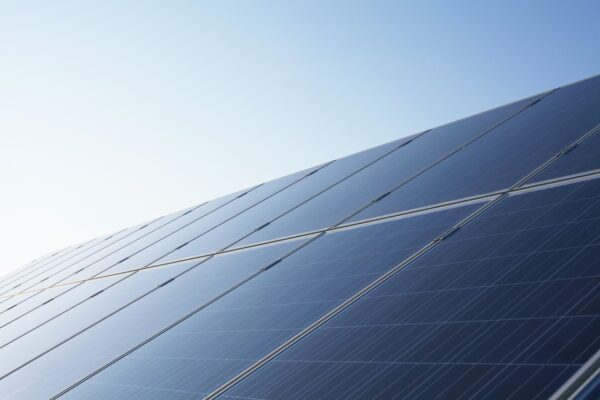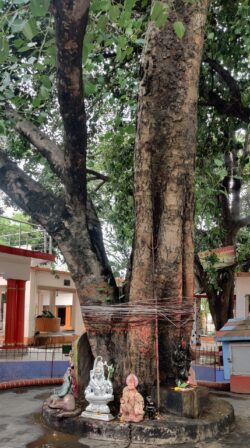The Pollution of atmosphere leads to severe consequences on local, regional, national and international levels.
On the local and regional levels, air pollution creates various types of problems against living and non- living environment. In the living environment it causes different types of physical, physiological and mental diseases. Besides many pollutants causing a number of diseases, the pollutants in domestic lives like – the smoke of cigarettes and carbon monoxide released into the air adversely affects the brain and the central nervous systems of human beings.
The gases like sulphur dioxide and nitrogen oxides cause acid rains when they combine with the rain water. This rain damages plants and causes considerable losses in their productivity by reducing the rate of photosynthesis. It makes the water of water bodies acidic and endangers the lives of aquatic animals and plants.
Acid of acid rain damages historical monuments and other buildings by reacting with their marble walls. These gases may cause deaths of humans and animals if inhaled in high concentration. Smoke, mist and fog cause dangers to living beings. Dust, particles of metals, asbestos, coal, and pathogens cause severe diseases of respiratory tract, skin and eyes etc.
On the global level atmospheric pollution produces serious consequences like the depletion of the ozone layer, global warming and the climate change. These problems produce many secondary problems on the global level.
Reducing the strength of pollutants so as to make them neutral or less harmful is called as abatement of pollution. Certain principles, guidelines and control devices are necessary to be followed and adopted for the abatement of pollutions of all types. These principles and guidelines together with control measures are being given below.
I. Methods of control of atmospheric pollution
A number of methods have been developed to control the atmospheric pollution. These methods are being introduced here as under –
A. Prevention of entry into the environment: According to this principle pollutants are checked at the point of their origin and are not allowed to enter into the environment by the application of specific devices.
B. Isolation: By isolation, we mean putting out or segregating pollutants at the point of their release or production. Such isolated pollutants should then be dumped at specific locations as per scientific guidelines adopted by pollution control agencies.
C. Conversion from highly toxic to lesser harmful product: We cannot stop industrial processes simply because they cause pollutions. However, we can reduce the toxicity or harmfulness of pollutants by applying bio- chemical technologies. A number of catalysts are introduced to reduce the toxicity of chemical pollutants produced during industrial processes.
D. Alternatives: These are safer substances used on the place of substances that cause hazards. For example bio- pesticides like oil of Neem and garlic extract, are better alternatives to synthetic chemical pesticides.
E. Destruction: The chemical pollutants which are proved to be toxic and are difficult to be substituted by safer ones, need to be blocked from further release and then destroyed in a safe and prescribed scientific manner. Advanced and Environment Friendly Incineration Technology and re- use for example re use of fly ash for making bricks.
F. Awareness: Matters pertaining to good citizenship, environmental consciousness and preventive methods must be explained to the common man, so that he may try to perform his duties with a high degree of civic sense. These awareness programmes through various media may involve radios, TVs. seminars, demonstrations, documentary films, pamphlets, display of hoardings, banners and plays etc.

G. Public Participation: The word ‘public participation’ means ‘sharing in common’ or ‘doing together’. In environmental context, it means, the involvement of the local public in solving their local environmental problems. It does not mean, people working under the planning and decisions of government agencies- it is rather bottom up approach. With joint efforts, people identify their problems, make plans to resolve them and then to implement them.
H. Environmental Education: The environmental education has been made a compulsory subject for studies at schools, colleges and other institutions. This is the most effective tool for the abatement of pollution and conservation of environment at different levels.
I. Self Restraint – A Habit: The greed of luxury and comfort initiates the production of newer and newer products. More and more products lead to more and more wastes which in turn pollute the environment more and more. That is why our ancient thinkers and philosophers preached on self restraint. Likewise, conservation should be made a habit.
J. Support to Professional Conservation Groups: The state and central governments should provide subsidies for conservation of environment and pollution control works being carried out by professional groups.
K. Legislative and Tax Measures: The existing laws for pollution control should be enforced properly so as to abate pollution. Industries pertaining to recycling of wastes, regeneration of forest and production of pollution free technologies should receive tax –concession from the government.
II. Practices of control of atmospheric pollution
1. Large scale plantation in village commons, along rail tracks and along road-sides and compensatory forestation should be done so as to keep up the balance of oxygen and carbon dioxide gases in the atmosphere.
2. Burning of coal, petroleum and its products should be minimized to control emission of gases like CO2, SO2, H2S and NOx.
3. Application of aerosol and CFCs should be substituted by the application of safe alternative.
4. Automobiles should be fitted with pollution control devices. Vehicles should be checked periodically for the control of pollutants.
5. Pollution control plants should be installed compulsorily in all the industries. Some emission control devices popularly used in industries and elsewhere for the control of particulates are: Fabric Filters, Wet Scrubbers, Cyclone Collectors, and Electrostatic Precipitators.
A. Fabric Filter: A unique mechanical device for filtering out particulate matter, in which fabric bags are used, is called as fabric filter.
B. Wet Scrubber: A specific device meant for scrubbing out the particulate matter present in a gas by passing the gas through wet chambers is called as wet scrubber.
C. Electrostatic Precipitator: An electric operated device for isolating fine particulate matter found in a gas by ionizing the particulates when passed through a strong electric field is called as Electrostatic Precipitator.
D. Cyclone Collector: A gas cleaning device which isolates dust particles by letting them pass along with the gas in a cyclonic manner. It works on the principle that when a gas travels in a double vertex, the particles contained in it are separated. The centrifugal force developed due to the spiral movement of the gas, expels the solid particles away from it.
6. Periodic monitoring and testing of industrial pollution should be insured by the agencies concerned.
7. People must be checked against burning of wastes including plastics and awareness should be generated in these regards.
8. A complete ban on shifting cultivation should be imposed in order to check air pollution.
9. Existing laws pertaining to pollution control should be enforced properly.




